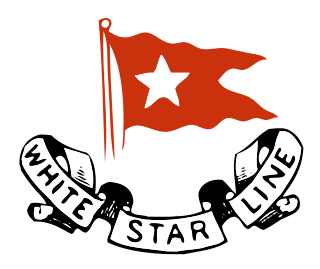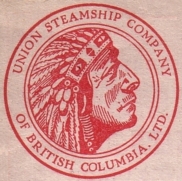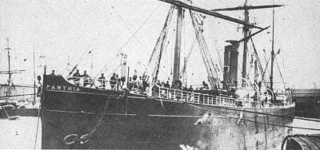
Saint Helena is one of the three constituent parts of Saint Helena, Ascension and Tristan da Cunha, a remote British overseas territory.

An ocean liner is a type of passenger ship primarily used for transportation across seas or oceans. Ocean liners may also carry cargo or mail, and may sometimes be used for other purposes. The Queen Mary 2 is the only ocean liner still in service to this day.

The White Star Line was a British shipping line. Founded out of the remains of a defunct packet company, it gradually rose up to become one of the most prominent shipping companies in the world, providing passenger and cargo services between the British Empire and the United States. While many other shipping lines focused primarily on speed, White Star branded their services by focusing more on providing comfortable passages for both upper class travellers and immigrants.

RMS Empress of Britain was a steam turbine ocean liner built between 1928 and 1931 by John Brown shipyard in Scotland, owned by the Canadian Pacific Railway Company and operated by Canadian Pacific Steamship Company. She was the second of three Canadian Pacific ships named Empress of Britain, which provided scheduled trans-Atlantic passenger service from spring to autumn between Canada and Europe from 1931 until 1939.

RMS St Helena is a cargo liner that served the British overseas territory of Saint Helena. She sailed between Cape Town and Saint Helena with regular shuttles continuing to Ascension Island. Some voyages also served Walvis Bay en route to and from, or occasionally instead of, Cape Town. She visited Portland, Dorset twice a year with normal calls in the Spanish ports of Vigo (northbound) and Tenerife (southbound) until 14 October 2011, when she set sail on her final voyage from the English port.

RMS Empress of Britain was a transatlantic ocean liner built by the Fairfield Shipbuilding and Engineering Company at Govan on the Clyde in Scotland in 1905–1906 for Canadian Pacific Steamship (CP). This ship – the first of three CP ships to be named Empress of Britain – regularly traversed the transatlantic crossing between Canada and Europe until 1923, with the exception of the war years. Empress of Britain was the sister ship of RMS Empress of Ireland, which was lost in 1914.

RMS Transvaal Castle was a British ocean liner built by John Brown & Company at Clydebank for the Union-Castle Line for their mail service between Southampton and Durban. In 1966 she was sold to the South Africa-based Safmarine and renamed S.A. Vaal for further service on the same route. Following cessation of the service between the UK and South Africa in 1977 the ship was sold to Carnival Cruise Line and rebuilt in Japan as the cruise ship SS Festivale, re-entering service in 1978. In 1996 she was chartered to Dolphin Cruise Line and renamed IslandBreeze. In 1998 the ship was sold to Premier Cruise Line, which renamed her The Big Red Boat III. Following the bankruptcy of Premier Cruise Line in 2000, The Big Red Boat III was laid up until 2003 when she was sold to scrappers in Alang, India. She was renamed The Big Red Boat for her final voyage to the scrapyard.

SS Celtic was an ocean liner built for the White Star Line by shipbuilders Harland and Wolff of Belfast.

RMS Empress of Japan was an ocean liner built in 1929–1930 by Fairfield Shipbuilding & Engineering Company at Govan on the Clyde in Scotland for Canadian Pacific Steamships (CP). This ship was the second of two CP vessels to be named Empress of Japan – regularly traversed the trans-Pacific route between the west coast of Canada and the Far East until 1942.

RMS Empress of Canada was an ocean liner launched in 1960 and completed the following year by Vickers-Armstrongs of Walker, Newcastle upon Tyne, England for Canadian Pacific Steamships Ltd. This ship, the third CP vessel to be named Empress of Canada, regularly traversed the transatlantic route between Liverpool and Canada for the next decade. Although Canadian Pacific Railways was incorporated in Canada, the Atlantic liners were owned and operated by the British registered subsidiary Canadian Pacific Steamships Ltd. and were always British flagged and manned and therefore Empress of Canada was not the flagship of the Canadian Merchant Marine.

RMS Empress of India was an ocean liner built in 1890-1891 by Naval Construction & Armaments Co, Barrow-in-Furness, England for Canadian Pacific Steamships. This ship would be the first of two CP vessels to be named Empress of India, and on 28 April 1891, she was the first of many ships named Empress arriving at Vancouver harbor.

SS Zeeland was a British and Belgian ocean liner of the International Mercantile Marine Co. (IMM). She was a sister ship to Vaderland and a near sister ship to Kroonland and Finland of the same company. Although her name was Dutch, it was changed during World War I to the less German-sounding SS Northland. She served for a time as a British troop ship under the name HMT Northland. Reverting to Zeeland after the war, the ship was renamed SS Minnesota late in her career. Zeeland sailed primarily for IMM's Red Star Line for most of her early career, but also sailed under charter for the White Star Line, the International Navigation Company, the American Line, and the Atlantic Transport Line, all IMM subsidiary lines. The pursers safe survived the scrapyard at Inverkeithing and after residing in a wardrobe for 80 years is currently on display in a local private home.

The Union Steamship Company of British Columbia was a pioneer firm on coastal British Columbia. It was founded in November 1889 by John Darling, a director of the Union Steamship Company of New Zealand, and nine local businessmen. The company began by offering local service on Burrard Inlet near Vancouver and later expanded to servicing the entire British Columbia coast.

RMS Ivernia was a Saxonia-class ocean liner, built in 1955 by John Brown & Company at Clydebank, Scotland for Cunard Line, for their transatlantic passenger service between the UK and Canada. In 1963 she was rebuilt as a cruise ship and renamed RMS Franconia, after the famous pre-war liner Franconia (1922). She continued to sail for Cunard until being withdrawn from service and laid up in 1971. In 1973 she was sold to the Soviet Union's Far Eastern Shipping Company and, renamed SS Fedor Shalyapin, cruised around Australia and the far East. In 1980 she was transferred to the Black Sea Shipping Company fleet, and for a time returned to cruising in the Mediterranean and around Europe. In 1989 she was transferred again, to the Odessa Cruise Company, and continued her career as a cruise ship until 1994. She was then laid up at Illichivsk, a Black Sea port 40 km (25 mi) southwest of Odesa, until 2004 when, as the Salona, she sailed to Alang, India, where she was scrapped.

Lavia was a cruise ship that caught fire and sank in Hong Kong Harbour in 1989. She was built for Cunard White Star Line in 1947 as the cargo liner Media. In 1961 she was sold to Italy, rebuilt as an ocean liner and renamed Flavia. In 1969, she was refitted as a cruise ship and renamed Flavian. In 1982 she was sold to Panama and renamed Lavia. She was undergoing a refit when the fire occurred. The damage to her was so great that she was scrapped.

Princess Norah was a steamship which operated in British Columbia and southeastern Alaska from 1929 to 1964. From 1955 to 1958, this ship was called Queen of the North. From 1958 to 1964, the ship was called Canadian Prince. This ship should not be confused with the later similarly named motor ferry MV Queen of the North.

Princess Marguerite, Princess Marguerite II, and Princess Marguerite III was a series of Canadian coastal passenger vessels that operated along the west coast of British Columbia and into Puget Sound in Washington state almost continuously from 1925 to 1999. Known locally as "the Maggie", they saw the longest service of any vessel that carried passengers and freight between Victoria, Vancouver, and Seattle. The vessels were owned and operated by a series of companies, primarily Canadian Pacific Railway Company (CPSS) and British Columbia Steamships Corporation. The first two were part of the CPR "Princess fleet," which was composed of ships having names which began with the title "Princess". These were named after Marguerite Kathleen Shaughnessy, who was not a princess but was the daughter of Baron Thomas Shaughnessy, then chairman of the board of CPSS's parent, the Canadian Pacific Railway (CPR).

SS Parthia (1870–1956) was an iron-hulled transatlantic ocean liner built for the Cunard Line by William Denny and Brothers in Dumbarton, Scotland. Her sister ships were the Abyssinia and Algeria. Unlike her two sisters, Parthia was smaller, built in a different shipyard and had a slightly different funnel arrangement. The Parthia was retired by Cunard in 1883 and sold to John Elder & Co., who subsequently transferred her to the Guion Line. After serving with the Guion Line and operating on trans-Pacific routes with the Canadian Pacific Railway Company, she was refitted and renamed Victoria.
Cambridge Ferry was a 3,294 GRT train ferry that was built in 1963 for the British Railways Board. She was sold to Malta in 1992 and renamed Ita Uno. She was renamed Sirio in 1993 and reflagged to Panama in 1998. The ship was scrapped in Turkey in 2003.

RMS Lady Nelson was a steam turbine ocean liner which served in passenger service from 1928 to 1968 and operated as wartime hospital ship from 1943 to 1945. One of a class of five sister ships popularly known as "Lady Boats", she was built for the Canadian National Steamship Company (CNS). The five vessels were Royal Mail Ships that CNS operated from Halifax, Nova Scotia and the Caribbean via Bermuda. Lady Nelson was sold to Egyptian owners in 1953 and served as Gumhuryat Misr and Alwadi until she was scrapped in 1968.


















